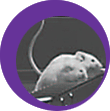Animal Models
Skip secondary menu
A number of animal models and associated data are available at a nominal cost to neuroscience researchers.
Deltagen/Lexicon Knockout Mice
Neuromice
GENSAT
Deltagen/Lexicon Knockout Mice

The National Institutes of Health (NIH) has signed contracts with Deltagen Inc. of San Carlos, Calif., and Lexicon Genetics Incorporated of The Woodlands, Texas, to provide NIH and its scientific partners with access to 251 lines of knockout mice that have been extensively characterized. For each mouse line, the contractors will provide not only the mouse line itself, but also detailed, objective data on the impact of the specific gene deletion on the mouse's phenotype, which includes appearance, health, fitness, behavior, ability to reproduce, and radiological and microscopic data. The new contracts provide NIH with irrevocable, perpetual, worldwide, royalty-free licenses to use and distribute to academic and non-profit researchers these lines of knockout mice. The mouse lines, which will be stored in the form of frozen embryos, frozen sperm and frozen embryonic stem (ES) cells, will be delivered to NIH-funded mouse repositories that supply mice to universities, medical schools and research labs all over the world. All data on the mice will be made available to researchers worldwide without restriction in publicly available databases on the Web. This resource will be available for a nominal fee which will be used to cover the cost of handling, shipping and replenishing the stock. Under the license agreements with Deltagen and Lexicon, researchers who receive the knockout mice lines through NIH are free to publish any results from research involving the line and also to seek patent or other intellectual property protection for any of the inventions or discoveries resulting from such research.
Related Sites:
Deltagen and Lexicon Knockout Mice and Phenotypic Data
Knockout Mouse Project (KOMP)
NIH Neuroscience Blueprint Animal Model
Contacts:
Dr. Robert Riddle, Program Director, NINDS
Dr. Chris Austin, Senior Advisor for Translational Research, NHGRI
Neuromice

The goal of Neuromice is to establish, characterize and distribute novel mutant mouse models for the worldwide research community. Neuromice is an NIH-funded collection of N-Ethyl-N-Nitrosourea (ENU) mutagenized mouse lines that have been preliminarily phenotyped and are available for purchase. Three mutagenesis and phenotypic screening facilities (Northwestern University, The Jackson Laboratory and the Tennessee Mouse Genome Consortium) focus on identifying alterations in nervous system function and behavior. The phenotypic domains include visible mutants, movement/neuromuscular function, emotional or social behavior, eye/vision, drug or alcohol abuse, auditory/vestibular, circadian rhythmicity, epilepsy, learning/ memory and growth/ development. About 225 mouse lines are currently available.
Related Sites:
Neuromice
Cre-Drivers for the Mouse Nervous System
Contacts:
Dr. Robert Riddle, Program Director, NINDS
C. Jeana Yates, Project Manager
GENSAT (Gene Expression Nervous System Atlas) is a publicly available gene expression atlas of the developing and adult mouse nervous system with images for ~3500 genes. Approximately 500 BAC transgenic mouse lines are also available with specific EGFP reporter or Cre recombinase expression in the nervous system.
Information about GENSAT can be found under Gene Expression Resources
Last updated December 17, 2008





